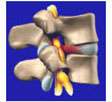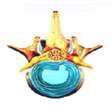Understanding Neck and Back Pain
Find your care
At the UCLA Health Spine Center, our experts diagnose, manage and treat all spinal injuries and conditions. Call 310-319-3475 to connect with a spine specialist.
Fax: 424-259-6560
The two primary symptoms of all spine-related conditions are neck and back pain. Pain is our body's way of telling us it needs attention. Neck and back pain can be caused by strain from repetitive use or overextension, or may result from traumatic injury.
Back pain, whether sudden or gradual, may be felt in one localized area of your back, or it may be felt widespread over the whole lower back. If the injury is sudden, it is likely to cause a severe stab of pain that may subside quickly or may persist. A more gradual pain usually starts mildly but builds to the stage of causing real discomfort. Certain movements or positions may aggravate the pain, while others relieve it. Back pain can also radiate down one or both legs, all the way to the feet.

Many different tissues can be damaged in a back injury. A severe compression injury, such as a fall from a height, can crush the body of a vertebra. A severe twisting injury can fracture the bony arch at the back of one of the vertebrae. Abnormal movements can strain any of the ligaments guarding the spinal joints. If a spinal joint is damaged, the muscles over it usually go into spasm, to fix the joint in a form of natural splint. This response stiffens that part of your back, creating even more pain if you then try to move it against the limiting factor of the tightened muscles.

The discs between your vertebral bones can be damaged in a variety of ways. The danger of disc damage increases as you get older, because the strong outer part, the annulus fibrosus, begins to degenerate, while the nucleus pulposus begins to lose its pliability and water-holding capacity.
The neck (cervical spine) is part of the spine and encloses and protects the cervical spinal cord. Neck pain, therefore, is often a response from similar conditions that cause other back pain. Also, like back pain, neck pain may cause referred symptoms, or radiation, along your arm into your hand. These symptoms may form a continuous line down your arm to your hand. A ligament strain or minor damage to a disc can cause intermittent referred symptoms that can be relieved by altering the position of the neck, perhaps stretching the neck away from the affected arm. A major disc problem more often causes unremitting pain.
Headaches and dizziness can also be caused by neck problems, either through spasm in the neck muscles or because the injury is interfering with the normal motion of the vertebrae.
Wear-and-tear arthritis can develop in the neck joints, causing pain in the neck with or without referred symptoms in the arms. It is important to maintain as much mobility and strength in the neck as you comfortably can, while avoiding stressing the joints with heavy loading or strenuous sports. Your doctor will advise you on the type and amount of exercise you should be doing on the basis of your symptoms and the changes visible on your x-rays.